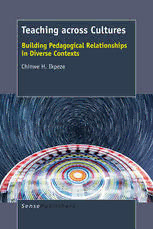
Teaching across Cultures: Building Pedagogical Relationships in Diverse Contexts PDF
Preview Teaching across Cultures: Building Pedagogical Relationships in Diverse Contexts
Teaching across Cultures Teaching across Cultures Building Pedagogical Relationships in Diverse Contexts Chinwe H. Ikpeze St. John Fisher College, Rochester, NY, USA A C.I.P. record for this book is available from the Library of Congress. ISBN: 978-94-6209-981-4 (paperback) ISBN: 978-94-6209-982-1 (hardback) ISBN: 978-94-6209-983-8 (e-book) Published by: Sense Publishers, P.O. Box 21858, 3001 AW Rotterdam, The Netherlands https://www.sensepublishers.com/ Printed on acid-free paper All Rights Reserved © 2015 Sense Publishers No part of this work may be reproduced, stored in a retrieval system, or transmitted in any form or by any means, electronic, mechanical, photocopying, microfilming, recording or otherwise, without written permission from the Publisher, with the exception of any material supplied specifically for the purpose of being entered and executed on a computer system, for exclusive use by the purchaser of the work. This book is dedicated to my husband, Mr. Okey Ikpeze, and our four wonderful children: Obidi, Chuka, Adaobi, and Chiamaka. Your unflinching love, support, and encouragement were a huge source of inspiration. You are my biggest cheerleaders and the reason my life is meaningful. Thank you for believing in me. I want to also thank Barbara Zinker, a dear family friend, for her enthusiasm and support. TABLE OF CONTENTS Acknowledgments xi Introduction xiii Chapter 1: Teaching as a Cultural Artifact 1 Introduction 1 Understanding Culture 2 Culture and Teaching 4 Perspectives on Culture 5 Cultural Assumptions and Practices 8 Cultural Politics and Education 9 Toward (Inter) Cultural Competence in Teacher Education 9 Concluding Thoughts 10 Chapter 2: Self-Study: Studying Self and Others 13 Introduction 13 Self-Study: Understanding Self and Others 14 Uncovering My Assumptions 15 Identifying Differences 16 Research Questions 19 Beliefs and Visions about Literacy Teacher Education 19 Why Teacher Educators Engage in Self-Study 21 Theoretical Framework 23 Minding the Gaps in Teaching and Learning 27 Concluding Thoughts 28 Chapter 3: Data Collection and Analysis 29 Introduction 29 Context of the Study 29 Characteristics of Self-Study Research Methods and Its Application to Current Study 31 Data Analysis 35 Conclusion 37 Chapter 4: Tensions in Teaching across Cultures 39 Introduction 39 Understanding Tensions 42 Institutional Culture 43 vii TABLE OF CONTENTS The Entitlement Culture 48 The Digital Culture 50 Invisible Cultures 52 Classroom Cultures 53 Tensions across Situations & Differences 54 Relational Tensions 58 Concluding Thoughts 61 Chapter 5: Toward Responsive Pedagogy 63 Introduction 63 Understanding Culturally Responsive Teaching 64 Characteristics of Culturally Responsive Teachers 66 Culturally Responsive Pedagogy in Teacher Education 68 Approaches to Culturally Responsive Pedagogy in Teacher Education 69 Rethinking Culturally Responsive Teaching 70 Toward Responsive Pedagogy in Teacher Education 72 Identifying the Gaps in Teaching and Learning 74 Closing the Gaps in Teaching and Learning 79 Responding to the Digital Culture through Technology Integration 87 Concluding Thoughts 91 Chapter 6: Building Relationships in Physical and Virtual Spaces 93 Introduction 93 Teaching as a Relational Process: Dimensions of Relationships 95 Building Relationship with Prospective Teachers 97 Utilizing Student Reflections 98 Making My Personal Life Visible 105 Students’ Perceptions and Relationships 107 Individual Conferencing 109 Modeling Best Practice 110 Maintaining Academic Rigor 112 Negotiating Authority 116 The Student and Peer Context of Relationship Building 119 Unfriendly, Difficult, or Disruptive Students 119 Strategies for Dealing with Hard-to-Relate to and Difficult Students 121 Small Group Collaboration 122 Building Relationship in Virtual Spaces 126 Blogging as a Pedagogical Tool 127 Meet the Academic Blogger: The Case of Jackie 129 Other Individualized Blog Conversations 133 E-mails, Gratitude, and Teacher–Student Relationship 136 Concluding Thoughts 139 viii TABLE OF CONTENTS Chapter 7: Teaching in the Third Space 141 Introduction 141 Theoretical Perspectives on Third Space 142 Social and Spatial Production of Space 143 Third Space, Globalization, and Teacher Education 144 Third Space and Teacher Education Practices 145 Facilitating Prospective Teachers’ Learning in the Third Space 152 Concluding Thoughts 161 Chapter 8: Social and Professional Networks 163 Introduction 163 Professional Socialization 164 Professional Organizations and Teacher Educator Development 165 A Day at the Literacy Research Association Conference 167 Special Interest Groups and the Professional Development of Educators 174 The Impact of Other Professional Associations 175 Concluding Thoughts 178 Chapter 9: Teaching across Cultures: Perspectives and Implications 179 Lessons Learned from Cumulative Self-Studies 179 Teaching across Cultures: Implications 184 Concluding Thoughts 191 References 193 Index 207 ix
